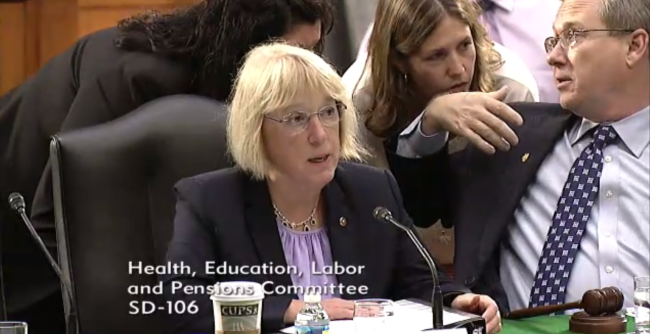You have /5 articles left.
Sign up for a free account or log in.

Senator Patty Murray at the hearing
U.S. Senate
As sexual violence on college campuses has attracted more attention in recent years, discussion has often turned to bystander intervention, the practice of intervening in a situation when another person needs help.
At a U.S. Senate education committee hearing Wednesday, bystander intervention got a boost as a possible solution to not only sexual violence, but also harassment and bullying. Several senators and witnesses raised concerns that colleges are not doing enough to prevent harassment and bullying. Institutions could do more, they said, by providing bystander intervention training for incoming freshmen and adopting antiharassment policies.
Senator Patty Murray, a Washington Democrat, commended the two Stanford University graduate students who held down convicted rapist Brock Turner until police arrived. “I admire the two students -- strangers and responsible bystanders -- who did step up and take action, which highlights the critical importance of bystander intervention,” she said, adding that bystander intervention can also help foster campus cultures that discourage harassment and bullying.
Melynda Huskey, interim vice president of student affairs and dean of students at Washington State University, said that all freshmen at Washington State are required to attend bystander intervention training “as early as possible” during their first semester. This training gives students an opportunity they might not otherwise have to practice important skills and behaviors, she said.
But Joseph Storch, associate counsel for the State University of New York System, said the first semester of freshman year may be too late. “To be effective, training and prevention must begin long before college orientation,” he said. “Students form their habits and interpersonal norms in high school or middle school.”
The Clery Act and Title IX of the Education Amendments of 1972, two federal laws aimed at campus violence and sexual misconduct, look backward to past violations, Storch said. But Congress and college administrators should look forward by investing in prevention efforts so that fewer violations occur, he said, adding, "We like to say that the best response to bullying, hazing and other violence is when you don’t need to respond at all because it didn’t happen in the first place."
Besides prevention training, witnesses also spoke of the need for antiharassment policies. Jane Clementi, co-founder of the Tyler Clementi Foundation, testified in support of the Tyler Clementi Education Anti-Harassment Act, which would amend the Higher Education Act to require colleges and universities that receive federal funding to enact antiharassment policies. In particular, the bill would require institutions to adopt a policy that explicitly prohibits cyberbullying.
The bill was named in honor of Jane Clementi’s son, Tyler, who jumped to his death from the George Washington Bridge as a Rutgers University freshman in 2010. Three days before Clementi committed suicide, his roommate used a webcam to film him kissing a man and tweeted about the incident. The day before the suicide, Clementi's roommate invited his Twitter followers to join him via webcam for a second viewing. (Note: This paragraph has been updated from an earlier version to clarify that Clementi was filmed with a man, not another student.)
The Tyler Clementi Education Anti-Harassment Act was first introduced back in 2010. Since then, the bill has stalled.
“When I first sponsored this bill, I was surprised to learn that there weren’t policies in place,” Murray said. “Colleges should be safe places for our students to learn.”
As Clementi was subjected to cyberbullying due to his sexual identity, several witnesses voiced support for shielding LGBT students from harassment and bullying. Colleges must take steps, they said, to ensure that students are not harassed because of their sexual orientation, gender identity or gender expression.
“LGBT students are at higher risk for all forms of harassment, from unkind words to physical assault,” Huskey said. “We need to be very aware that we have a special responsibility for outreach to them.”
In September 2015, the Association of American Universities released one of the largest-ever surveys on campus sexual assault, which found that three in four LGBT students had experienced sexual harassment. But data on the rate at which LGBT students face bullying, harassment and hazing remains harder to come by.
Senator Elizabeth Warren, a Massachusetts Democrat, said more data on this topic may need to be collected. “I am a huge believer in data,” she said. “Data help us understand what’s happening.”
The Tyler Clementi Foundation has made it a priority to collect such data, Jane Clementi said. “The new executive director plans to survey colleges about what’s being done for LGBT students and what’s working and not working, and which schools have programs in place,” she said.
While witnesses expressed concern for LGBT students and the lack of data regarding them, they drew on an abundance of statistics to stress that harassment and bullying nonetheless affect all students.
About 55 percent of college students involved in clubs, teams and organizations experience hazing, said Elizabeth Allan, executive director of StopHazing.org and professor of higher education at the University of Maine. This compares to 47 percent of students entering college, she said.
Hazing is even more common among athletes and members of fraternities and sororities, Murray said. Approximately 74 percent of varsity athletes and 73 percent of fraternity and sorority members have experienced at least one hazing behavior, including sleep deprivation and forced alcohol consumption, she said.
While most research on bullying and harassment has focused on students in middle school and high school, the behavior persists well into college and affects many college students, said Rick Amweg, a consultant for Security Risk Management Consultants and former director of campus safety and security for the Ohio Board of Regents. “Part of the problem stems from the different way bullying and related activities are defined,” he said. “Some behaviors typically labeled as bullying in high school are not considered so in college.”
Over 3.2 million students at all education levels are victims of bullying each year, Clementi said. “That number is astronomical and unacceptable,” she said. “This is not a rite of passage -- this is a public health threat.”




